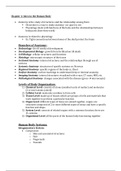Study guide
Anatomy Midterm Notes
- Course
- Human Anatomy (HLSC120)
- Institution
- MacEwan University ( )
These are notes from my Human Anatomy class from nursing! They include 6 chapters of full detailed notes that include pictures and diagrams! Chapters include: Intro to Human Anatomy, Tissues, Integumentary System, Bone Tissue, Joints and much more! This document is 59 pages and is what helped me p...
[Show more]



